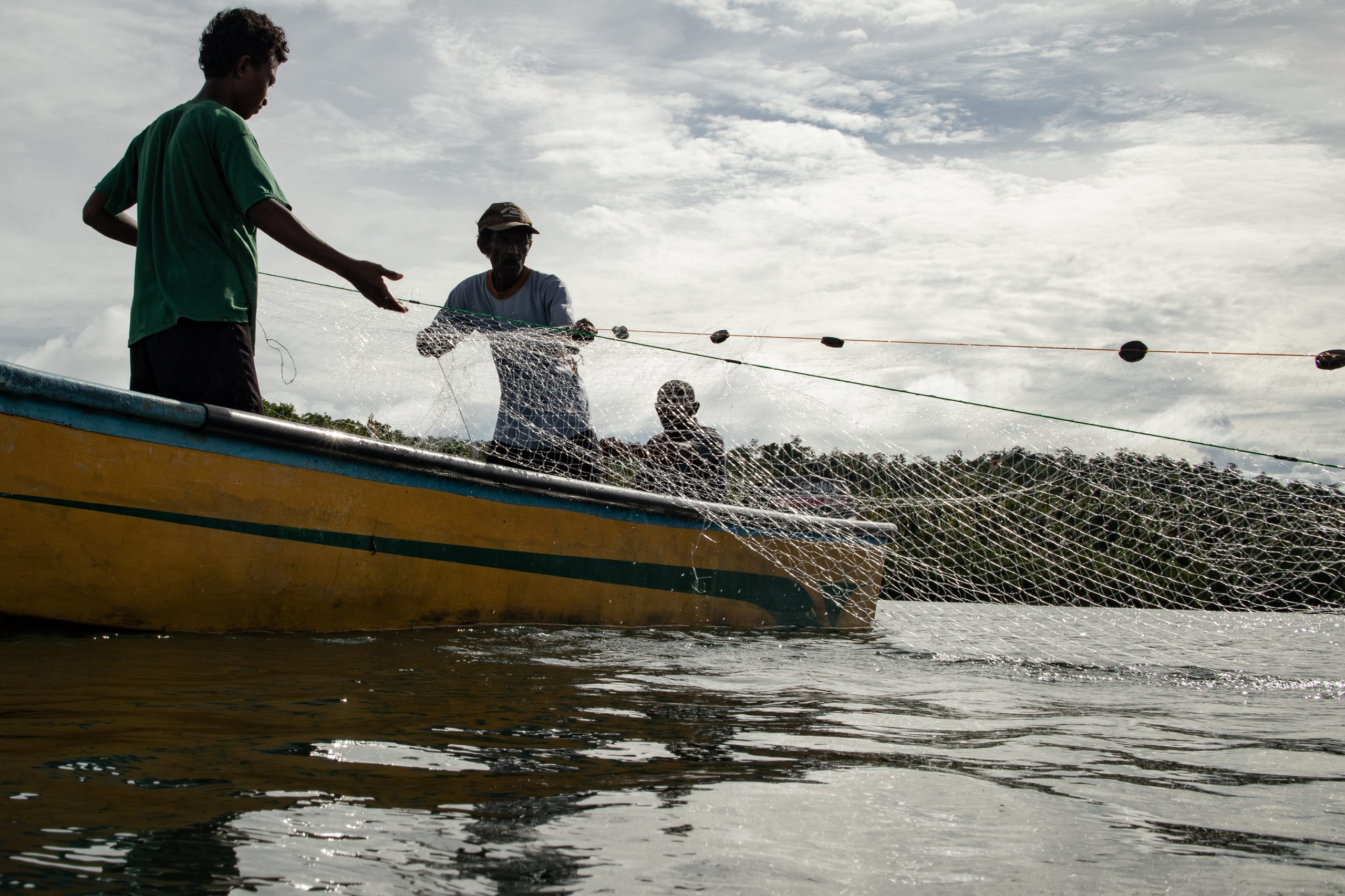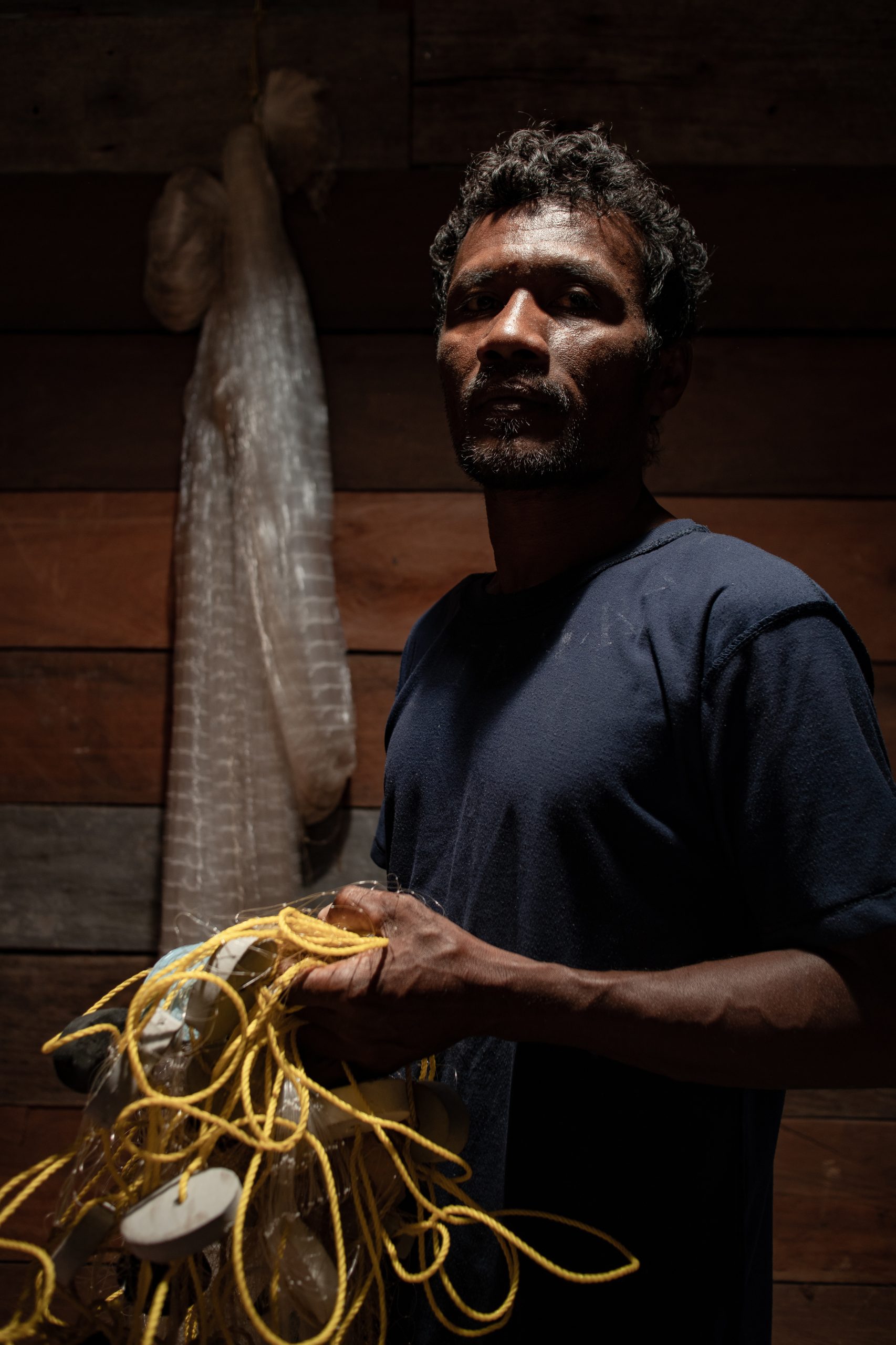
Nama Andan is one of the small islands in Maluku Province, inhabited by a total of 98 households. Located in Waru Bay, about 8.5 kilometers from Tanjung Ilor, Seram Island. The island stretches for five kilometers and is surrounded by coral reefs and mangroves.
The waters between Parang Island and Seram Island are known to be very deep, more than 180 meters. It is also known as the limestone island, a coral reef structure can be found in its core.
Despite its remarkable natural beauty, the island has its imperfection too. Electricity is not properly installed and clean water is difficult to fetch. People rely only on the collected rainwater.
That morning, a small boat with a 15 HP engine anchored at the beach of Belis Village, Teluk Waru Sub District, Seram Bagian Timur District, Maluku Province. The captain of the boat was Mr. Imam, that is how we address him.
Five people wanted to cross over to Nama Andan Island at that time. We left at 10:00 WIT and arrived around 11:30 WIT.
Arriving on the island, we headed to Ramli Rumeon’s house. The 31-year-old man welcomed us warmly. He entertained us with coffee and chocolate biscuits. The house was as tall as an adult’s calf with timber walls, facing the sea. When the tidal flood came, the sea water could reach his terrace.
“Last April, the water hit the terrace,” said Ramli, pointing to the front of his house on Tuesday, May 20, 2025. “It has been an annual guest. The flood happens two to three times.”
The sea condition, he continued, greatly affects the lives of fishermen like him. He can only go fishing when the weather is good and the sea water is high. That is the right time to go fishing.
Ramli is a traditional fisherman. He goes fishing on a 15 HP engine boat. Every time he goes fishing, he needs about two liters of gasoline. Gasoline in Nama Andan Island costs 18 thousand rupiahs per liter. For one fishing trip, Ramli can catch 15-40 kilograms of fish, depending on the weather and season. The catches include rabbitfish (baronang), skipjack tuna, and mackerel. He goes fishing three to four times a week.
Each catch is then stored in ice blocks to keep it fresh. “Bring it to Waru in three days after the catch reaches 100 kilograms,” he explained. “Then, back home with some ice blocks. So, every drop counts.”
In Waru District, the fish was sold for 20 thousand rupiahs per kilogram. Ramli bought 150 ice blocks with the money for the next three days. The ice costs 5 thousand rupiahs for four blocks.
The fish will rot easily if we use less ice. That is a loss considering a round trip to Waru uses up 15 liters of gasoline. Fortunately, Ramli always manages to carry at least 100 kilograms of fish to sell.

Handline to Net Fishing
Nama Andan Island is one of the administrative villages in Parang Island, located in the southeast of the Seram Sea. In 2023, the island was inhabited by 372 people, most of them were fishermen.
One of them is Ramli. He practiced handline fishing for 15 years and sold the catches in the village for 10 thousand rupiahs per five fish. That was not enough to cover his family’s daily expenses. He wished to sell the fish to Waru, but the operational cost was high.
“For 20 fish caught, you will only get 20-30 thousand rupiahs. It doesn’t cover the fuel cost,” said the father of four.
In 2015, he decided to switch to net fishing. He bought a net, 100 meters long, for IDR 200,000. When the sea water rises in the afternoon, he promptly goes for fishing, usually around 15.00 WIT and pulls out the net at 19.00 WIT. Whereas during the west monsoon, Ramli goes fishing at dawn around 04.00 WIT and pulls the net in the morning.
The fishing location is relatively close to his house. He sets the net by noticing the tide. “The water is low (low tide) for only a moment. The net is pulled out after at least two or three hours,” he explained.
People’s livelihoods that rely heavily on nature are one of the challenges for rural communities, especially in eastern Indonesia. Knowing that, the Inclusive Rural Livelihood Development Program in Eastern Indonesia (BangKIT) encourages livelihood improvement through community-based planning in integration with the local government planning. As in Nama Andan Village, where most people are fishermen, the weather prominently affects their activities. Learning more effective fishing techniques will improve income to cover their needs when they cannot go fishing due to bad weather.

BangKIT Program then facilitated sustainable livelihood planning in Nama Andan Village in November 2023. Community mapped out the condition of their village, identifying village potentials and problems. They also developed a plan to solve the identified problems and to escalate the existing potentials.
As a result, Technical Training on Capture Fishery Development and Fishermen Group Management was held in response to the proposed community plan. And, a stimulation package was delivered to support the livelihood activities.
After nine years of net fishing, Ramli received assistance in the form of an additional net for 50 meters long and 370 meters wide from the BangKIT Program stimulation package. To make it a longer net, he divided the net by its width into two, 185 meters each, then combining the two and making it 100 meters long.
“Before participating in the BangKIT Program, I had used a net,” he uttered. “The support made it longer.”
His net is 200 meters long now, therefore, he is taking a friend to go fishing. Ramli needs help to unfold the long net. The yield is then shared for two.
Boat and Engine Installments
Despite the net, a boat is the key instrument to go fishing. Ramli paid installments for a boat in six months, paying 1 million rupiahs per month to the boat builder in Waru District.
“Early 2024, I paid off the ship installments thanks to the fishing yields,” he said.
Not only the boat, he also paid installments for a 15 PK engine worth 20 million rupiahs. Now, all the installments have been paid off. Thanks to the long net and stable amount of yields, he can earn over 2 million rupiahs per sale for daily expenses.

He explained that some men who participated in the training held by the BangKIT Program in 2024 are no longer fishermen. They cannot survive fishing at sea. Many of us work on the copra when the bad weather interrupts the fishing activities.
Making copra, Ramli said, takes a long time and extra energy. We must climb the trees, collect, split, and smoke the coconuts. This process happens for 12 days.
“I work on copra, if the weather is bad, and I cannot go fishing,” he added.
Young People Leave the Island
Last couple of months, young people in Nama Andan Island prefer to migrate. They flock to the capital of Seram Bagian Timur District. Travelling on land by car. Then, by boat to Weda Sub District, Central Halmahera District, North Maluku Province, to work in the nickel mining.
“No more young people here. They’ve all gone to work in the mines,” said Pak Imam – Usman’s nickname, while chatting at his house.
PHOTO 04
At the moment, the only youngster on Nama Andan Island is Erik Maba, the son of Pak Imam. He did not migrate because he just graduated from high school and would like to pursue higher studies at university.
But his desire to continue studying cannot be done in 2025 due to the financial issue. Pak Imam said Erik wants to continue his studies, but his older sibling is also studying at the university. It is hard for the family to cover.
“Erik really wants to continue his studies, but we cannot afford it,” Pak Imam said.
Most people in Nama Andan Island make money from copra and their fishing business. Copra is dried coconut flesh. And, sadly, they cannot rely on fishing when the weather is bad. This why young people leave their village.
